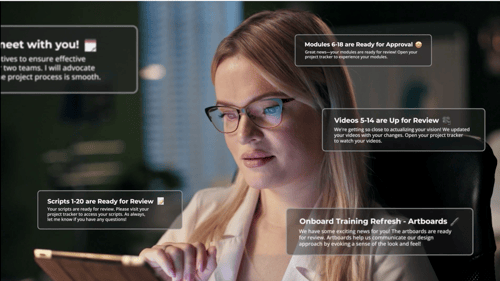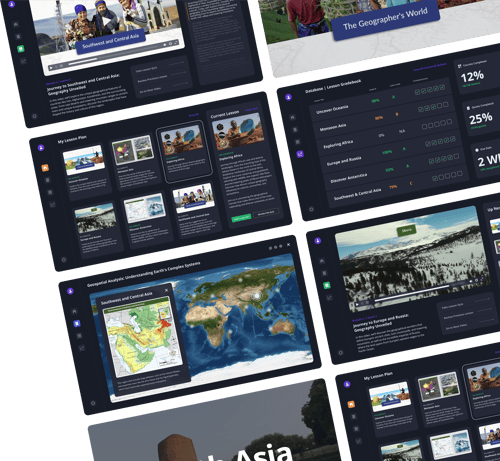In today's rapidly shifting corporate landscape, the way that companies approach employee training and development has evolved significantly. With all the tools and techniques available, video content has emerged as one of the most powerful and effective forms of communication, revolutionizing the way companies educate and empower their workforce.
In this post, we delve into the use of video content for employee training and development, exploring its nuances, benefits, and the different types of training videos available. Discover the power of visual learning, harness the expertise of subject matter professionals, and unlock the potential of interactive elements, all while taking your training initiatives to new heights.
What are Corporate Training Videos?
Corporate training videos are a versatile form of instructional content that plays a pivotal role in educating employees. They can vary widely in style and purpose, both accelerating new-hire onboarding and serving continuing professional development needs.
For new-hires, visual media can introduce employees to a company’s culture, values, and policies, along with outlining job-specific requirements. To promote further professional development, videos focus on enhancing existing abilities, whether that means customer service techniques, adoption of new industry technologies, or leadership skill refinement.
Why Use Corporate Training Videos?
The use of video content for training offers companies numerous advantages. First and foremost, video engages learners more effectively than traditional text-based materials. The combination of visual and auditory elements captures attention and enhances retention. Videos work particularly well when demonstrating complex processes or real-life scenarios, making learning more relatable and actionable. Furthermore, well-crafted videos featuring real people or subject matter experts establish a sense of credibility and relatability, enhancing the learning experience.
What Types of Training Videos Are Available?
When it comes to crafting effective training videos, it's important to consider the specific goals and needs of your development program. Different types of training videos cater to a wide array of learning styles and objectives. Here are four distinct formats that organizations commonly employ as part of their training plan:
Job-Specific Orientation:
These videos are the cornerstone of any comprehensive onboarding process. They introduce new team members to their roles, responsibilities, and the broader organizational structure they are joining. Job-specific orientation videos go beyond a mundane list of duties; they provide insights into the company's values, culture, and long-term vision. Well-crafted onboarding videos set the tone for an employee's journey within the organization and help them feel like a valued part of the team from day one.
Tutorial/Explainer Style Training:
Explainer videos are excellent tools for breaking down complex topics into easily understandable segments. Whether introducing new software, demonstrating a workflow, or explaining intricate concepts, tutorial videos prove invaluable. By combining visual cues with clear narration, these videos guide employees step by step, ensuring they fully grasp the subject matter at hand. This type of video is particularly beneficial for conveying technical information or standardized procedures consistently across an organization.
Scenario Recreation/Simulation:
One of the most engaging forms of training videos involves recreating real-life scenarios. By depicting common workplace situations and challenges, these videos allow employees to navigate a scenario and witness the potential outcomes of their decisions, without the risk to the person or organization. Simulation videos are particularly useful for customer service training, conflict resolution, and compliance education. By offering a safe environment for practice, these types of training sessions can improve employees’ confidence before facing real-world situations. These videos can even be incorporated into interactive experiences.
Functional Job Analysis:
These in-depth analysis videos delve into the specifics of individual job functions. They often include detailed process walkthroughs, showcasing the exact steps required to complete tasks with optimal efficiency. From assembling intricate machinery to preparing hand-tossed pizza dough, these videos break down any task into manageable segments. This type of training video is ideal for roles that involve hands-on tasks and precise procedures, ensuring that employees master each aspect of their job. And mastery can lead to higher job satisfaction and real business impact.
The Process of Creating Training Videos
Creating impactful training videos is a comprehensive, multi-stage process. Each phase contributes to the overall quality and effectiveness of the final product.
Research and Learning Design:
Before diving into video production, it's crucial to understand your target audience, their instructional preferences, and the specific learning outcomes you aim to achieve. This phase involves conducting needs assessments and defining clear objectives. By aligning your video content with these goals, you ensure that your training videos deliver impactful, measurable value.
Scripting and Visual Planning:
Crafting a well-structured script is the foundation of an effective training video. In fact, you can proactively boost learning video engagement with a few specific tips. Your script should outline the content flow, narration, on-screen text, and visual cues. Visual planning involves storyboarding and visualizing how different scenes will unfold. This phase lays the groundwork for the actual production process. Not spending sufficient time on this step can lead to unforeseen difficulties and missed opportunities once the camera starts rolling.
Production including Animation/Effects:
The production phase brings your script to life. For live-action videos, this includes ensuring proper lighting, sound quality, and visual composition. For animated videos, it is key to collaborate with skilled animators in order to create engaging visuals that complement the content. Animation can have a range of complexity. When exploring animation for learning, people often wonder: 2D graphics vs 3D graphics. Which is more effective? It can come down to which visual presentation will enhance understanding and engagement for the target audience.
Revision and Quality Assurance:
Once the initial video is produced, review it rigorously. Ensure that the content aligns with the learning objectives, the script is clear and concise, and the visuals support the narrative. Test the video with a sample audience to gather feedback and make any necessary revisions. Quality assurance is essential to ensure your video meets the high standards you set for your organization.
Distribution and Promotion:
After finalizing the video, determine the best platforms for distribution. This could include learning management systems, internal company websites, or dedicated training portals. To promote engagement, consider incorporating interactive elements like quizzes, discussions, and downloadable resources. It is also advisable to track engagement metrics in order to evaluate the video's effectiveness and make improvements as needed.
Video in the Corporate Training Program
Corporate training videos are integral to a company’s larger instructional design strategy. Instructional design involves crafting comprehensive training programs that align with the organization's employee development goals. This encompasses needs analysis, content creation, assessment, and iteration. Videos fit seamlessly into this framework by providing engaging, scalable, and consistent training material.
Enhancing Your Corporate Training Videos
Corporate training videos are integral to a company’s larger instructional design strategy. Instructional design involves crafting comprehensive training programs that align with the organization's employee development goals. This encompasses needs analysis, content creation, assessment, and iteration. Videos fit seamlessly into this framework by providing engaging, scalable, and consistent training material.
Creating outstanding corporate training videos requires careful planning and attention to detail. Here are some valuable tips to help your training videos stand out and deliver exceptional value:
Engaging Scripting:
Craft a script that's not only informative but also engaging. Use relatable examples, anecdotes, and real-life scenarios to connect with learners on a personal level.
Visual Appeal:
Utilize a variety of elements to maintain visual interest. Incorporating a mix of live-action footage, animations, graphics, and text overlays all work to reinforce key points.
Interactivity for Engagement:
Foster active learning through interactive elements. Insert knowledge checks, quizzes, and scenarios that encourage viewers to apply what they've learned.
Personalization:
Tailor your content to resonate with your target audience. Address specific known pain points, challenges, and aspirations that are relevant to your employees' roles.
Professional Production:
Invest in professional video production companies to ensure high production quality. Well-shot videos with clear audio and crisp visuals reflect positively on your training program's credibility.
Accessible and Bite-Sized:
Break down content into manageable segments. Ten four-minute videos are far more likely to hold a viewer’s attention than four ten-minute productions. This approach facilitates learning retention and helps to accommodate different learning styles.
By following these guidelines, your corporate training videos can transcend conventional training methods, making learning an engaging and valuable experience for employees across the organization.
Video content is a powerful tool for employee training and development that brings real-world scenarios and expertise directly to learners in the most engaging format. Whether it's through live-action instruction, animated explainers, or interactive modules, well-crafted training videos can revolutionize the learning experience, making it more captivating, effective, and impactful for employees and organizations alike. If you're looking to harness the potential of video content for your corporate training needs, partnering with professional video production companies can help you create compelling, informative, and visually captivating training materials.
At NextThought, we prepare people for what’s next for them. For employee training and development, that means engaging video that equips and retains new-hires. Contact us to learn more and find out what we can do to take your development programs to the next level.

NextThought team
NextThought transforms workplace learning through creative technology and engaging media. We're fortunate to partner with some of the top organizations in the world to make their educational training content remarkable and effective.
Recent Posts

What Can Go Wrong With A Custom Training Project? (And How NextThought Makes It Go Right)
August 5, 2025 1 Min Read

How Much Does a Custom Content Development Project Cost?
July 9, 2025 3 Min Read

The 6 Best Educational Video Production Companies (2025)
February 28, 2025 9 Min Read

